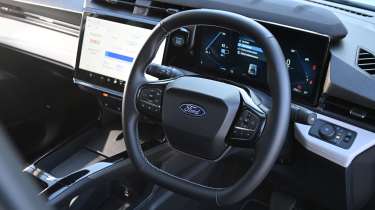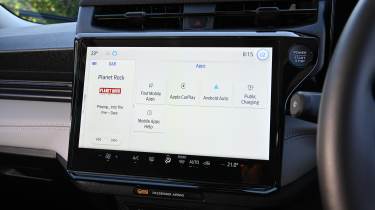Even a longer stint of motorway driving couldn’t shift the average below 4.4mi/kWh, while figures in the 5-6mi/kWh range were easily achieved at urban speeds. The fact that the Puma Gen-E manages this without compromising its driving ability makes the figures even more impressive. The small battery means a range of 202 miles at the rate we achieved on test, but that’s a similar distance to that posted by less efficient rivals with larger usable packs.
Charging speeds are a little disappointing, with a maximum rate of 100kW on offer. That’s the same figure achieved by the Renault 4/5, and means the Puma can go from 10-80 per cent capacity in 23 minutes when plugged into a powerful enough DC source.
| Model | Battery size | Range | Insurance group |
| Ford Puma Gen-E | 43kWh | 234 miles | 18 |
Insurance groups
The Puma’s sheer numbers mean that parts availability is good, although the Gen-E is in car insurance groups 18 and 19, with only the high-performance Puma ST sitting higher. That’s still a pretty good group rating, though; electric versions of the Peugeot 2008 and Vauxhall Mokka sit in group 22 and higher, while the Renault 4 is in groups 27 and 28.
Tax
Low list prices mean that the Puma Gen-E will be a cheap company car to run. Road tax for the Gen-E is the same as that for the standard Puma (£195) since EVs now pay it at the same rate as any combustion-engined car.
Depreciation
The Puma’s ubiquity means that residuals are only average, but the Gen-E performs just as well as its petrol sibling, retaining between 48 to 50 per cent of its original value after three years or 36,000 miles. In comparison, the hotter Puma ST retains 54 per cent
That’s a lot better than the Vauxhall Frontera, which in electric form is only expected to retain around 37 per cent of its original value.
A smooth nose and new centre console mark out the Gen-E from the petrol Puma

| Pros |
|
| Cons |
|
With the demise of the Ford Fiesta, it’s down to the Puma to fly the flag for Ford’s small cars, and as a result, it has become a common sight on UK roads. That’s no bad thing, because its compact dimensions and tight proportions mean it looks smart. The Gen-E adds a smoother nose up front and machined alloy wheels that look as if they should boost efficiency, but overall, the look remains unchanged.
Interior and dashboard design
Inside, the big updates are to the centre console, where a new split-level design is used. The drive selector has moved to the steering column – as with Ford’s other EVs, the Gen-E has its indicators and wipers on a single stalk to the left of the wheel.
Materials and build quality
The Gen-E feels just as well built as the petrol Puma, with harder plastics lower down in the cabin that feel sturdy, plus leather-effect trim on the dashboard for a more premium feel. One gripe we have is that the new centre console is finished in gloss-black plastic, which feels as if it will pick up scratches easily.

Infotainment, sat-nav and stereo
The most recent update to the Puma introduced a dashtop sound bar, similar to the set-up found in the Explorer and Capri. It comes with B&O branding on the higher-spec Premium and Sound Edition trims.


